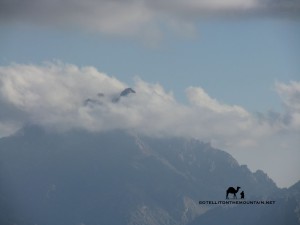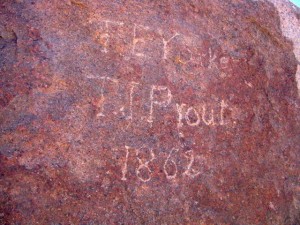September 5, 2014
Jebel Umm Shomer: a history
 Jebel Umm Shomer is an amazing peak. One with a high, pointed top that looks almost alpine – especially in the snow – and which stands in one of the most hard-to-reach parts of the Sinai. Europeans in particular were always fascinated by Jebel Umm Shomer; mostly because of its height. Up until the 19th century ,they reckoned it was Egypt’s highest peak: NOT Jebel Katherina, as we know it is today (Jebel Umm Shomer is the SECOND highest peak in Sinai and Egypt at 2537m). The Bedouin never saw its height as important in the same way; for them, this was a more magical, mythical mountain. They once said an immortal maiden lived on top; one whose hair flowed in rich waves down her back and who filled the valleys with her enchanting song.
Jebel Umm Shomer is an amazing peak. One with a high, pointed top that looks almost alpine – especially in the snow – and which stands in one of the most hard-to-reach parts of the Sinai. Europeans in particular were always fascinated by Jebel Umm Shomer; mostly because of its height. Up until the 19th century ,they reckoned it was Egypt’s highest peak: NOT Jebel Katherina, as we know it is today (Jebel Umm Shomer is the SECOND highest peak in Sinai and Egypt at 2537m). The Bedouin never saw its height as important in the same way; for them, this was a more magical, mythical mountain. They once said an immortal maiden lived on top; one whose hair flowed in rich waves down her back and who filled the valleys with her enchanting song.
The first attempt – the first attempt in written records, anyway – was made by Jean Louis Burckhardt: the son of a Swiss aristocrat who moved to Germany, became almost destitute in London, then landed a dream job as an explorer.
He’s the guy who’s credited with re-discovering the ancient city of Petra.
 Anyway, he travelled through the Sinai in the early 19th century, penning a hugely readable travelogue (Travels in Syria & The Holy Land – definitely worth a look). He loved mountains. And Jebel Umm Shomer wasn’t the only one he tried. He went to Jebel Serbal too – another of the Sinai’s most majestic peaks – but headed up the wrong summit after an argument with his guide. At least, he didn’t do the highest one. Which, I think, is what he meant to do AND what he thought he’d done!
Anyway, he travelled through the Sinai in the early 19th century, penning a hugely readable travelogue (Travels in Syria & The Holy Land – definitely worth a look). He loved mountains. And Jebel Umm Shomer wasn’t the only one he tried. He went to Jebel Serbal too – another of the Sinai’s most majestic peaks – but headed up the wrong summit after an argument with his guide. At least, he didn’t do the highest one. Which, I think, is what he meant to do AND what he thought he’d done!
Jebel Umm Shomer’s peak isn’t hard-to-find. It towers above you all the way. Burckhardt started the climb in a ravine that runs up the mountain. At the top of this ravine, he took a breather; huge views opened up over the sea to mainland Egypt and he gazed down to the port of El Tur. Between him and the top were now just the last cliffs, and he wrote this in his journal:
“Umm Shomer rises to a sharp, pointed peak, the highest summit of which it is, I believe, impossible to reach; the sides being almost perpendicular, and the rock so smooth, as to afford no hold to the foot. I halted about 200 feet below it, where a beautiful view opened upon the sea of Suez“.
So he turned back there, declaring the mountain unclimable. Others tried after him, but none of them found a way to the top.

The mountain remained unclimbed – by Europeans, anyway – for about half a century. Two Englishmen – T.E Yorke and the Reverend T.J Prout – were the first on top in 1862. And a local Bedouin guide showed them the way (as ever, the Bedouin had been up this mountain long before Europeans; their climbs just aren’t recorded in writing). They submitted an account to Britain’s Royal Geographical Society – ‘ASCENT OF UMM SHOMER: THE HIGHEST PEAK OF THE SINAITIC PENINSULA‘ – which you can still read today. They walked in from St Katherine, camping at a spot called Zeituna before carrying on over Jebel Abu Shajara – Mountain of the Tree – to Burckhardt’s ravine.
Here’s what the Rev T.J Prout where Burckhardt stopped:
“It is a little higher up [ie from the top of the ravine] that the difficulty of the mountain occurs. The huge buttresses which support the biggest summit are, at first sight at least, quite insurmountable. But on further inspection the perpendicular face of one of these buttresses is found to be rent by a fissure… gradually contracting until there is barely room for a man. On the floor here boulders rise within reach of a small ledge…”
From this ledge they carried on, threading through the crags to the top.

Since then, Jebel Umm Shomer has been climbed many times. It’s well-known to any enthusiast of the Sinai’s mountains. If you get the chance, you should definitely do it too. You’ll follow that same route in the ravine that Burckhardt wrote about nearly 200 years ago; and which Yorke and Prout finished describing later. If you DO go, be sure to have a good look around the top, because there’s some interesting stuff. I found the names of T.E Yorke and T.J Prout carved on a boulder (obviously there from way back in 1862). There’s a pilgrim’s crucifix carved in an early style too (meaning an outsider was probably on the top centuries before Burckhardt even tried). Also, there’s a footprint scratched on a rock: an old form of Bedouin marriage proposal – which you can read more about HERE – which I’d love to think was something to do with the Bedouin story of the immortal maiden who lived on top…
Don’t be worried by the accounts of early explorers either. Jebel Umm Shomer is a good scramble: that’s it. The way is well-marked and there’s nothing technical. And nothing too exposed. So how do you do it? First of all, head to St Katherine; go to a local Bedouin camp, and arrange a 4×4 – or a camel – to a place called Zeituna. Zeituna is the name of the spot you start the walk to the mountain; there’s an old garden with a well here. If you want to sleep, there’s an unlocked storeroom that belongs to the Monastery of St Katherine too. You can use that as shelter. There ARE other approaches: if you’re feeling adventurous you can start in South Sinai’s capital El Tur: this way, you’ll approach the mountain through Wadi Isleh – a spectacular gorge – then go up Wadi Rimhan. If you want even more adventure start at St Katherine and go via Wadi Jibal and Naqb Umm Siha: from here you go down to Wadi Zeraigiyeh, which you can follow up to the mountain past the ruined chapel and mosque of Deir Antush.